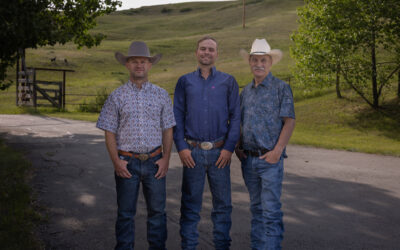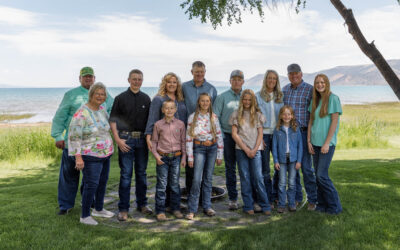
Build beef quality, profit
by Janet Kanters
November 28,2011
Canadian feedlots and ranchers can cooperate to improve beef produced from cowherds across the nation, all in the interest of profitably growing demand.
Domestically and around the world, the beef already has a reputation for unsurpassed safety and traceability, along with the high quality of grain feeding.
The next level is to track and improve individual carcass quality.
“We’ve built our production protocols with that in mind,” says Travis Hickey, general manager of cattle strategies for Western Feedlots, with custom feeding operations near Strathmore, High River and Mossleigh, Alta. Working together, the industry can expand both supply and demand for high-quality beef by recording and sharing data, and then using it. “Today, we can provide weights on arrival, average daily gain during the feeding period, death loss, carcass weight, quality grade and yield grade, all on an individual basis,” he adds.
Charlie Fullerton, who uses Angus bulls on black and black baldy cows north of Pincher Creek, Alta., has been feeding with Western for more than 20 years. He retained ownership until the last two years when he sold directly to the feedlot, which has shared performance and carcass data for several years.
“That lets us see which cows and bulls are doing the best; I’ve culled some cows partly on their carcass data,” says Fullerton. The improvement in grade from 50 per cent AAA to 75 per cent AAA he attributes to both culling the lower end and adding more Angus genetics.
“A lot of people don’t think about premiums for quality, or even know what they have. You don’t unless you feed them,” says Fullerton. “Then if they don’t perform on the grid, you’ve got to start changing something.”

Another 20-year customer, Twin H Cattle Co., near Goodsoil, Sask., looks forward to getting individual data now. Trevor Himmelsbach and his family start calving their 800 Angus-base cows in later winter. They are weaned in October and custom fed at Western Feedlots.
“We’ve seen the group data for many years, but could not link that to our own records until now,” says Himmelsbach.
“We’ve had a big improvement, but looking forward to more,” he says. “The bulls I use for AI, I try to select those that will marble well, get a good ribeye and a little less fat – high grid bulls you might say.
Being able to select on the cow side as well, we can make more improvement in those traits.”
Group data showed Certified Angus Beef ® (CAB®) brand acceptance less than 20 per cent and no more than one per cent Prime. “That’s not where I want those to be,” says Himmelsbach. “We can make a lot of progress there, looking back on which cows are producing CAB and Prime, and AI’ing those to get even better replacements in their progeny.”

The more data, the easier it is to see the effect of a change in feeding program, implant or market weight. The more known the more value, but it’s a dynamic set of data, says Hickey.
“Genetics change from one year to another with the use of different bulls, and there can be large variation within a herd,” he says. “We work with producers in understanding how their cattle performed relative to their cohorts in the areas of performance, health and carcass attributes.”
Western sorts individual cattle into the yard and as they are ready for market to reduce variation in carcass weight and manage optimal end-points.
“We encourage cow-calf producers to get more than just carcass data back, because without other information it is of very little value,” adds Hickey. “For example, as the industry adopts beta-agonists and new implant technologies, it drastically alters the carcass composition.” Knowing the information context helps keep genetic selection on track.
Of course, marbling and quality grade are often up for discussion as part of the entire “complex puzzle.”
“All else being equal, an average yielding carcass that grades upper AAA and fits the CAB brand can be worth $50 per head more than AA of the same weight,” says Hickey.
It’s not uncommon for a load of Western-fed cattle to go 80 per cent AAA, and some 100 per cent or better, but the CAB share has been more commonly in the 10 to 15 per cent area. That can improve while making progress on feed efficiency at the same time, says Hickey, based on company data. That is, you don’t have to give up quality when selecting for feed efficiency.
That tandem focus—quality with efficiency—is the key to producing beef that will attract more consumers, both domestic and globally.
Hickey says foreign delegations that tour Western Feedlots are “blown away” by the level of individual information and traceability. “And they trust our feeding programs. This is becoming more important with the average consumer everywhere, so Canada is in a great position moving forward.”
You may also like
Zybach Angus Receives Certified Angus Beef Progressive Partner Award
Steve Zybach’s vision for smaller Angus producers to get more value for their calves through feeder calf sales with value-added programs led him to be recognized as the 2025 CAB Progressive Partner.
Cross Cattle Company earns Certified Angus Beef Canadian Commitment to Excellence award
Using disciplined breeding, genetics and hands-on management to raise Angus cattle that consistently hit high standards, Cross Cattle Company’s focus on quality earned them the 2025 Canadian Commitment to Excellence award.
Willis Ranch Earns Commercial Commitment to Excellence Award
Willis Ranch combines traditional stockmanship with modern genetic tools to produce cattle that thrive and meet high-quality carcass targets. Earning them the 2025 Commercial Commitment to Excellence award.



